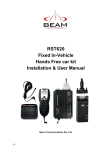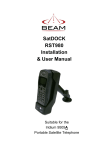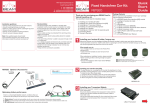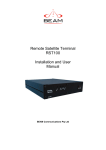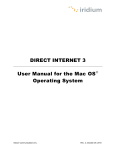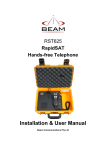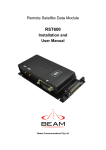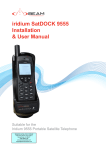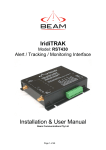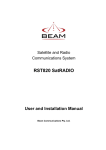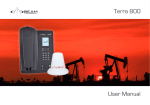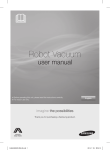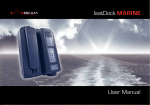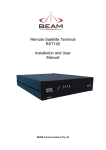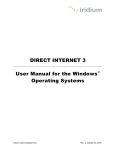Download RST620 User Manual
Transcript
RST620 Fixed In-Vehicle Hands Free car kit Installation & User Manual Beam Communications Pty. Ltd. |23 RST620 INSTALLATION & USER MANUAL Remote Satellite Terminal RST620 Installation and User Manual Version 1 BEAM Communications Pty Ltd 8 Anzed Court, Mulgrave, Victoria, 3170, AUSTRALIA Information furnished by BEAM Communications Pty Ltd (BEAM) is believed to be accurate and reliable. However, no responsibility is assumed by BEAM for its use, or for any infringement of patents or other rights of third parties, which may result from its use. No license is granted by implication or otherwise under any patent or patent rights of BEAM. BEAM reserves the right to change specifications at any time without notice. Copyright © 2009 BEAM Communications Pty Ltd. All rights reserved Product name: Manual revision: Part Number: Release date: RST620 In Vehicle Hands Free Car Kit 1 USRMAN005001 Jun 2009 2 RST620 INSTALLATION & USER MANUAL Package Contents Check that your RST620 package contains: 1 x RST620 Hands Free Interface (HFI) module 1 x Intelligent Handset & cradle 1 x Speaker 1 x Microphone 1 x 9522B Iridium L-Band transceiver 1 x L-Band transceiver bracket & Velcro fastener 1 x L-Band transceiver cable 1 x 3-wire Power cable harness & 2 Fuses 1 x SMA – TNC Antenna Cable Adaptor 1 x socket wrench / Allen key 1 x Printed RST620 User Manual 1 x Printed Iridium Antenna Installation Guide Optional Accessories The following optional accessories are available for your RST620. • Handset Extension Cable • Antenna Cable • Antenna See your Service Provider for pricing and availability of these quality BEAM accessories. 3 RST620 INSTALLATION & USER MANUAL User information Please record your serial number here for future reference: Model: BEAM RST620 Serial no #: This number can be copied from the white shipping label on the RST620 box Eg. HFI02803 The following PIN codes may be required to use your RST620, please complete these details for future reference. PIN Name SIM PIN Supplied by your Service Provider PUK Supplied by your Service Provider Function Symptom Unlocks SIM card to enable calls to be made Signal LED flashes Red Unlocks a locked SIM card Signal LED flashes Red Your PIN 4 RST620 INSTALLATION & USER MANUAL Contents Package Contents 3 ELECTRICAL LEGEND 24 Convenient On/Off Feature 24 Entertainment Mute Feature (optional) 24 Horn Alert (Ring) Feature (optional) 25 Line In/Out (optional) 25 Preliminary Testing 26 Operation of the In-Car Kit 27 Optional Accessories 3 User information 4 Safety Information 7 Conventions in this Manual 7 Antenna Care 8 Phone Operation 8 Driving 8 Electronic Devices 8 Pacemakers 9 Other Medical Devices 9 Vehicles 9 Posted Facilities 9 Aircraft 9 Potentially Explosive Atmospheres 10 For Vehicles Equipped with an Air Bag 10 About BEAM Communications 11 Checking Performance after Installation 27 Checking the Entertainment Mute Feature 27 Important Operational Notes 27 Hands-free Interface LEDs 28 TURN THE POWER ON AND OFF 28 Assuring Quality of Iridium Service 29 About your RST620 12 Cabling 29 RF Interference 29 Features 12 Symptoms of RF Interference 29 Mitigation of RF Interference 29 Using the Communication Port 30 Equipment Overview 14 Side A 14 Side B 14 Installation Guidelines 15 RS232 Data Port 30 Using the Line In/Out 31 Routing Cables 15 Iridium Display Definitions 32 Using Your Intelligent Handset 33 Guidelines for Electrical Connections 16 Installation Procedure 17 Power-On Messages 33 Phone Overview 34 1. Installing your handset & holder/hang–up cup 17 Automatic Redial 35 Redial Last Number Called 35 International Dialing 35 Dial a Number from the Phone Book 35 Emergency Number Dialing 35 Ending a Call 35 Receiving Calls 35 Receiving Hands-free calls 36 Receiving Personal Calls on the handset 36 Unanswered Calls 36 2. Installing your Hands Free Interface Unit (HFI) 18 3. Installing your Transceiver Module & SIM Card 18 4. Installing the Directional Microphone 20 5. Installing the Speaker 21 6. Installing the Antenna 22 7. Connecting Power to Components 23 5 RST620 INSTALLATION & USER MANUAL Voicemail Mailbox 36 Changing From Private to Hands-free 36 Adjusting Earpiece Volume 36 Adjusting Ringer Volume 37 Using In-Call Feature: Muting a Call 37 Using the Menus 37 Navigate the Options Menus 37 Using the Quick Access Menu 38 Activate the Feature Directly 38 Default Quick Access Settings 38 Using the In-Call Menu 38 In-Call Menu Features 39 Managing the Phone Book 39 Entering the Phone Book Menu 39 Organising Your Phone Book 39 Getting to Personal Numbers... 40 Setting the Ringer Tone 44 Getting to Phone Setup... 44 Setting the Keypad Tones 44 Locking and Unlocking Your Phone 44 Lock the Phone Automatically 45 Lock the Phone Instantly 45 Unlock the Phone 45 Change the Unlock Code 45 Getting to Require SIM Card PIN... 45 Protecting the SIM Card 45 Activate and Deactivate the SIM Card PIN Code 46 Getting to Require SIM Card PIN... 46 Change the SIM Card PIN Code 46 Storing Names and Numbers 40 Unblock the PIN Code 46 Add an Entry 40 Entering Names 40 Correcting an Entry 40 Getting to Phone Setup... 46 Selecting the Display Language 46 Reset Options to Factory Defaults 47 Calling, Modifying, or Erasing an Entry 40 Clear All Stored Information 47 Accessing the Network Selection Menu 47 Call a Selected Entry 40 Modify a Name or Number 40 Erase a Name and Number 41 Storing Your Voicemail Number 41 Getting to Network Selection... 48 Registering With the Satellite Network 48 Getting to Show Call Timers... 48 Showing Call Timers 48 Show the Time of the Last Call 48 Show Total Time for All Calls 48 Getting to Audible Call Timers... 49 Specification Summary 50 Managing Your Messages 41 How Your Phone Notifies You of Messages 41 How Messages Are Stored 41 What Messages Contain 42 Accessing Your Messages... 42 Read a New Messages Notification Message 42 Go to the Next Message 43 RS232 (Comm Port) Specification 51 Physical Connection 51 RS232 Port Signal Support and Handshaking 51 RS232 Port Electrical Parameters 51 9522B Mounting Bracket Dimensions 52 Return a Call from number in message 43 HFI Mounting Dimensions 53 Customising Phone Features 43 Troubleshooting 54 Text Messages 42 To read a Stored Message 42 Delete Messages 42 Accessing Your Messages... 43 Entering the Phone Setup Menu 43 BEAM Warranty Conditions 57 Getting to Phone Setup... 43 Adjusting the Ringer Volume 44 6 RST620 INSTALLATION & USER MANUAL Safety Information IMPORTANT! Please read the following information carefully before installing and using this BEAM equipment. Failing to follow instructions may compromise the safety of the product and may result in personal injury and/or equipment damage. Please consult your supplier if you have any further questions. Your RST620 is a low power radio transmitter and receiver, when ON, it receives and sends out radio frequency (RF) signals. The design of your RST620 system complies with international safety standards. Refer to the appropriate section of this RST620 Installation & User Manual for additional safety information. Warning: Do not open equipment. There are no user-serviceable parts inside. If a DC power supply is to be used, its output must comply with the Safety Extra Low Voltage (SELV) requirements of IEC60950. All connectors must only be connected to equipment ports which comply with the Safety Extra Low Voltage (SELV) requirements of IEC60950.” Conventions in this Manual Warnings, cautions and notes appear throughout this manual and are represented by following conventions. Warning: This symbol and associated text indicate a warning note providing information to prevent personal injury or damage to equipment. Note: This symbol and associated text indicate a note providing general operating information. Interference: All wireless phones may get interference, which could affect performance. Record: Write details of your unit for easy reference when required. Ideal when troubleshooting. 7 RST620 INSTALLATION & USER MANUAL Exposure to Radio Frequency Signals Your wireless mobile telephone is a low power radio transmitter and receiver. When it is ON, it receives and also sends out radio frequency (RF) signals. International agencies have set standards and recommendations for the protection of public exposure to RF electromagnetic energy. • International Commission on Non-Ionizing Radiation Protection (ICNIRP) 1996 • Verband Deutscher Elektrotechniker (VDE) DIN-0848 • United States Federal Commission, Radio Frequency Exposure Guidelines (1996) • National Radiological Protection Board of the United Kingdom, GS 11, 1988 • American National Standards Institute (ANSI) IEEE. C95. 1-1992 These standards are based on extensive scientific review. For example, over 120 scientists, engineers, and physicians from universities, government health agencies, and industry reviewed the available body of research to develop the updated ANSI standard. Antenna Care Use only the supplied or an approved replacement antenna. Unauthorized antennas, modifications, or attachments could damage the phone and may violate local agency regulations. Please refer to your Service Provider for further information. Phone Operation Do not operate your mobile telephone when a person is within 4 inches (10 cm) of the antenna. A person or object within 4 inches (10 cm) of the antenna could impair call quality and may cause the phone to operate at a higher power level than necessary and expose that person to RF energy in excess of that established by the FCC RF Exposure Guidelines. Driving Check the laws and regulations on the use of wireless telephones in the areas where you drive. Always obey them. Observe the following guidelines when using your phone while driving. Give full attention to driving—driving safely is your first responsibility. Use hands-free phone operation, as provided by this kit Turn off the road and park before making or answering a call if driving conditions so require. Electronic Devices Most modern electronic equipment is shielded from RF signals. However, certain equipment may not be shielded against the RF signals from your wireless phone. 8 RST620 INSTALLATION & USER MANUAL Pacemakers The Health Industry Manufacturers Association recommends that a minimum separation of six inches (6") be maintained between a wireless phone’s antenna and a pacemaker to avoid potential interference with the pacemaker. These recommendations are consistent with the independent research by and recommendations of Wireless Technology Research. Persons with pacemakers: Should ALWAYS keep the phone more than six inches from their pacemaker when phone is turned ON Should turn the phone OFF immediately if you have any reason to suspect interference is taking place Other Medical Devices If you use any other personal medical device, consult the manufacturer of your device to determine if it is adequately shielded from external RF energy. Your physician may be able to assist you in obtaining this information. Turn your phone OFF in health care facilities when any regulations posted in these areas instruct you to do so. Hospitals or health care facilities may be using equipment that could be sensitive to external RF energy. Vehicles RF signals can affect improperly installed or inadequately shielded electronic systems in motor vehicles. Check with the manufacturer or its representative regarding your vehicle. You should also consult the manufacturer of any equipment that has been added to your vehicle. Posted Facilities Turn your phone OFF in any facility where posted notices require. Aircraft Airline regulations prohibit using your phone while in the air. Consult the local Aviation Authority for guidelines on use of the equipment on board an aircraft. 9 RST620 INSTALLATION & USER MANUAL Potentially Explosive Atmospheres Turn your phone OFF and do not remove your battery when you are in any area with a potentially explosive atmosphere. Obey all signs and instructions. Sparks from your battery in such areas could cause an explosion or fire resulting in bodily injury or even death. Areas with a potentially explosive atmosphere are often but not always clearly marked. They include, but are not limited to: o fueling areas such as gasoline stations; o below deck on boats; o fuel or chemical transfer or storage facilities; o areas where fuel odors are present (for example, if a gas/propane leak occurs in a car or home); o areas where the air contains chemicals or particles, such as grain, dust, or metal powders; o any other area where you normally would be advised to turn off your vehicle engine. For Vehicles Equipped with an Air Bag An air bag inflates with great force. Do NOT place objects, including both installed and portable wireless equipment, in the area over the air bag or in the air bag deployment area. If in-vehicle wireless equipment is improperly installed and the air bag inflates, serious injury could result. 10 RST620 INSTALLATION & USER MANUAL About BEAM Communications Beam Communications, a wholly owned subsidiary of World Reach Limited (WRR), listed on the Australian Stock Exchange, is a world leader in design, manufacture and distribution of specialized communications equipment for the Iridium Satellite Network. Beam’s commitment to be at the forefront has continued to increase its share of the global satellite communications market. Its premium distribution network spans the world. Recognized as a leading provider of satellite communication solutions, Beam specializes in Voice, Data, Tracking and customized solutions. Beam develops innovative products and services to meet market demands and niche applications. Beam’s leading edge products are deployed in a wide range of vertical markets including Maritime, Transport, Government, Defense, Mining, Construction, Forestry, Emergency Services, Relief Aid, Telemetry and Rural Telephony. Supported by a dedicated team of professionals, Beam has developed solid relationships with its peers and network of distributors worldwide. Beam Communications Pty Ltd 8 Anzed Court, Mulgrave, Victoria, 3170, AUSTRALIA Web: www.beamcommunications.com Info: [email protected] Support: [email protected] Tel: +61 3 8588 4500 Fax: +61 3 9560 9055 11 RST620 INSTALLATION & USER MANUAL About your RST620 This guide outlines the details for installing the Beam In-vehicle hands free telephone. This kit should not be used with any other device other than the components supplied. Features Full In-vehicle Integration The Beam In vehicle kit allows for a quality permanent installation to the vehicle. The antenna, microphone and speaker are simply installed in a convenient location within the vehicle following the instructions provided with the kit. The handset is simply installed in a cradle or secure location ready for use. Functionality The major advantage of an in-vehicle kit is the hands-free use along with the permanently installed antenna for increased call quality and signal penetration. The Intelligent Handset will support all the standard functionality whilst being used with the Beam In-vehicle kit. Intelligent Handset Interface The In-vehicle kit uses the Beam Intelligent Handset, RST970. The handset supports voice calls as well as utilizing the Iridium SMS service. The handset is compact and includes an inbuilt ring alert. The handset also enables a private in vehicle conversation, when the handset is taken out of the cradle (cup). 12 RST620 INSTALLATION & USER MANUAL RS232 Data Port A RS232 serial data port is provided via the “Comm Port” allowing data calls, or tracking / alerting modules or a PC to be connected. Refer to the AT commands guide on the CDROM for modem commands. (Optional) Alert / Tracking Interface The Beam LeoTRAK terminals are an intelligent Alert / Tracking and Monitoring unit all-inone and are available for all Beam terminals. LeoTRAK allows the deployment of various applications including vehicle, asset, asset tracking, monitoring and condition reporting, remote control and configuration. Alert/Alarm monitoring applications are available. The LeoTRAK interface is highly intelligent and the ability to configure many parameters in the terminal locally or remotely enables a great deal of customization and flexibility. Key Features: Convenient Hands-free Operation Supports Intelligent Handset Handset Charging Horn Alert Integration 11-32V DC Input 13 Supports Voice & Data Services Full Duplex Hands-free Operation Echo Cancellation Stereo Integration Capable (Line I/O) Supports DC Power Input Convenient Installation RST620 INSTALLATION & USER MANUAL Equipment Overview Side A Side B RED = +BATT (11 to 32 VDC) BLACK = -BATT (GND) GREEN = ACC PWR 14 RST620 INSTALLATION & USER MANUAL Installation Guidelines Wherever you install your equipment, follow these guidelines: The units must be protected from dirt and moisture. Ensure that each mounting surface is strong enough to support the component being mounted to prevent the component from loosening over time. The space around the units is sufficient to allow for cooling. Select sites for mounting components that do not interfere with driver or passenger seating or leg space. Ensure that any wires or cable that attach to the item being mounted will not interfere with driver or passenger seating or leg space. Mount all components securely to prevent shifting that could cause injury or could interfere with safe vehicle operation. Always use the supplied mounting hardware. The units can be easily removed. The location allows for adequate clearances for cables Only qualified personnel should install communication equipment. If necessary, contact the vehicle manufacturer for air bag information specific to the vehicle. Caution: Air bags inflate with great force. DO NOT place objects, including communication equipment, in the area over the air bag or in the air bag deployment area. If the communication equipment is improperly installed and the air bag inflates, serious injury could result Routing Cables If your vehicle is equipped with wiring troughs in the doorsills, use them to simplify cable installation and to provide maximum protection for the cables. If wiring troughs are not available, route cables according to these guidelines: Route cables so they are protected from pinching, sharp edges, and crushing Where possible, avoid routing cables above the catalytic converter Use grommets wherever a cable must pass through a hole in a metal panel In a vehicle equipped with electronically controlled anti-skid brakes, route all cables on the opposite side of the vehicle from the braking modulator box to minimize possible interference from the phone. Keep all in-line connectors accessible. 15 RST620 INSTALLATION & USER MANUAL The suggested path for routing cables in vehicles without wiring troughs is alongside the drive shaft hump, under the carpet. Guidelines for Electrical Connections The System is designed to operate in negative ground 11-32 volt electrical systems only. The best power connection point for the positive primary power leads is the positive terminal of the vehicle battery. Often, direct connection to the battery is inconvenient, and you may find it easier to connect the positive leads to the starter solenoid. Always select a point as close as possible to the battery. Connect the negative primary power leads to a good ground point on the vehicle chassis or at the battery. Many parts of the vehicle can produce electrical noise that interferes with the electrical radio system operation. The ignition system is the most common source of electrical noise interference. Before you begin installation, ensure that the ignition wiring and connections to the vehicle battery are in good working condition. Verify that low resistance connections are present between the battery negative terminal, the vehicle chassis, and the engine block. All wire connections should be clean and tight. At 13.6 volts, the phone draws less than 3 amps when transmitting. Confirm that the vehicle’s battery and alternator have sufficient current capacity to deliver at least 3 amps more than the maximum current that may be required by the vehicle and its other accessories. Warning: Do not connect the RST620 to the connector cable until the full installation is completed. 16 RST620 INSTALLATION & USER MANUAL Installation Procedure Install the components in the following order: 1. Installing your handset & holder 5. Installing your Speaker 2. Installing your Hands Free Interface Unit (HFI) 6. Installing your Antenna cable & Antenna system 3. Installing your Transceiver Module & SIM Card 7. Connecting Power to Components 4. Installing your Directional Microphone 1. Installing your handset & holder/hang–up cup Mount the hang-up Cup of the Intelligent Handset so that the handset is within easy reach of the driver during normal operation. Remembering that the handset needs to also connect to the Hands Free Interface. Allow enough room so that you can easily insert the smart handset into and remove it from the hang-up cup. Pic 1 Pic 2 Pic 3 Step 1 Remove cover on hang-up cup (Pic 1) Step 2 Affix the Hang-up cup in location using the holes in the cup (Pic 2) Step 3 Once in place replace cover on hang up cup 17 RST620 INSTALLATION & USER MANUAL 2. Installing your Hands Free Interface Unit (HFI) In many vehicles, the best location for these units is on the floor or the rear vertical panel of the trunk compartment. Alternate locations include under the dashboard, under the front or rear seat, or under the rear speaker deck panel. Caution: Always use the supplied mounting hardware for mounting the units. If not mounted properly, the transceiver may shift when the vehicle is moving, which can interfere with proper operation of the vehicle. Performance of electronically controlled brake and/or guidance systems can, under certain unique conditions, be subject to interference by mobile radio operation. Although the transceiver exceeds all requirements regarding radio frequency emissions, you should mount the transceiver as far as possible from the guidance system and/or braking modulator box (usually located in the trunk) to minimize any possible interference. The best location for mounting the HFI Adapter Box is under the dashboard or front seat within reaching distance of the handset when in the cradle. To install the box, follow these steps: 1. Using the Hands Free Interface as a template, mark the screw hole locations. 2. Remove the bracket, and use an awl or similar device to start the holes at the marked locations. 3. Drill the holes & mount using the six screws provided with the fuse kit. 3. Installing your Transceiver Module & SIM Card Mounting the Transceiver Mount the Transceiver module in a safe location away from driver obstruction. Ensure the distance between the transceiver module and the Hands Free Interface enables the D25 Connector cable to reach both units. Use the 3x 4mm slots located in the mounting bracket to mount the transceiver module in the suitable safe location. 18 RST620 INSTALLATION & USER MANUAL Installing SIM Card 1. Use the hex wrench (Allen key) to remove the screw on the transceiver module to remove the SIM card cover plate as shown. Keep the screw in a safe place whilst you install / remove the SIM card. SIM card Housing Remove with Allen Key 2. Once the cover is removed slide the plastic SIM card holder sleeve (opposite direction of the arrow) to release it from the locked position. 3. Insert the SIM card as shown, with the golden connectors facing inwards and the ‘cut corner’ of the SIM card facing uppermost. 4. Close the plastic sleeve down, and slide in the direction of the arrow until you feel it click into place. 5. Replace the cover, and fasten the screws. Caution: Scratching or bending the SIM card can easily damage the card or its metal contacts. So handle the SIM card with care. Avoid exposing the card to static electricity. 19 RST620 INSTALLATION & USER MANUAL 4. Installing the Directional Microphone The hands-free directional microphone must be properly positioned in the vehicle to ensure optimum performance. When selecting a location for the microphone, consider these guidelines: Mount the microphone near the centre of the vehicle, either on the driver-side sun visor or on the head-liner above the driver. Do not position the microphone where it may be blocked by the visor. Position the microphone so that it faces the user of the mobile when the user is seated normally. Do NOT position the microphone near a window or in any location where road noise or any ambient background noise may be high (above 85 dB SPL). Do NOT position the microphone where it will be affected by the output of the speaker (see below). Follow these steps to mount the microphone: 1. Installing the microphone cable in a concealed area, where the cable will not get damaged, typically down the drivers A pillar, 2. The microphone can then be simply left exposed to a short distance as per the picture below. The microphone should be installed in a location that is no greater than 45cm / 1’6” away from the driver. Distance greater than this will cause an attenuated voice level received. The microphone can also be installed in the centre of the cabin if required so it is central to the vehicles interior space. Follow these guidelines for positioning the microphone: 1. Do not place the microphone so that the visor can block it when flipped up or down. 2. Do not place the microphone where it is exposed to direct air flow from an open window 3. Route the cable carefully to ensure that it does not get crimped by any heavy objects or enclosures this will avoid damaging the cable. 4. Ensure the Microphone is not installed in a location that is subject to excessive driving or this may impact on the call quality. 20 RST620 INSTALLATION & USER MANUAL 5. Installing the Speaker Follow these steps to mount the speaker: 1. Mount the speaker to the transmission hump or underneath the dashboard on the passenger side. 2. Do not mount the speaker so that it faces the microphone directly or this will cause heavy feedback within the system. 3. Route the cable carefully to ensure that it does not get crimped by any heavy objects or enclosures this will avoid damaging the cable. The speaker can be mounted in a convenient safe location where it does no obstruct the driver. The bracket attaches to the Speaker using the bolt supplied. The Bracket itself can be then mounted in a suitable position. Correct microphone/speaker positioning. It is advised the speaker be mounted under the dashboard, on the transmission hump, or in another suitable location, using the mounting bracket supplied with the speaker assembly. When selecting a location for the speaker, consider these guidelines: Position the speaker so that it does not interfere with vehicle operation or with driver or passenger seating or leg space. Avoid locating the speaker behind a sound-absorbing barrier (for example, facing upward under a seat or behind a dashboard panel). Do NOT position the microphone where it will be affected by the output of the speaker 21 RST620 INSTALLATION & USER MANUAL 6. Installing the Antenna Iridium Antenna Connector GPS Antenna Connector. (NOT USED) The antenna cable should be connected to the “ANT” antenna socket of the transceiver module as shown above. The transceiver is fitted with an SMA connector, however a converter to change the connecter to TNC is included in the kit. Ensure the antenna cable is within specification for the length to maximise the quality of service and minimise loss of signal due to poor or lengthy cables. Once the cables are in place ensure they are firmly secured so as to ensure they do not work loose with vibration. For detailed information on antenna installation and placement please see the specific “Iridium Antenna Installation Guide” available from www.beamcommunications.com GPS Feed Through Specification The GPS feed through connector is provided to allow an Iridium 9522B and a GPS module to share a single antenna. Then the GPS receiver module can be connected to the GPS feed through connector output on the 9522B. When the 9522B is powered but not transmitting, any GPS signal received on the antenna is passed through to the GPS output. Either a passive or an active GPS module can be connected to the 9522B GPS port. The gain from the 9522B antenna input to the GPS connector is 0dB (+/- 2dB). The GPS output is available at all times when the 9522B is powered, except during the transmit cycle. (During the transmit cycle there will be some energy at the Iridium frequency which may adversely affect the AGC system of some GPS receivers.) NOTE: THE TRANSCIEVER MODULE DOES NOT HAVE A GPS ENGINE INSIDE The GPS antenna input is feed-through only. You will need your own GPS device to make use of the GPS antenna connector. 22 RST620 INSTALLATION & USER MANUAL 7. Connecting Power to Components Caution: Failure to follow these steps may cause the accessory not to work properly and may cause damage to your equipment. Warning: DO NOT connect the terminal to the Battery Supply until the installation is complete. 1. Ensure the power and Interface cable to the RST620 Interface Unit will reach from the RST620 unit to the point at which vehicle power is being sourced DO NOT connect to the interface box until after the installation is complete. 2. Route the power cable from the RST620 Interface unit to the connection point. 3. Note: To limit ground loops and high impedance ground paths, run the green/redstripe and black wires directly to the battery, or as close as possible to the battery. Use a grommet or other protection to prevent wear on metal surfaces for these wires. 4. Prepare the fuse block. Remove all fuses, and tape them to their respective holders, before making any connection. DO NOT insert fuses until you have completed and inspected all connections. 5. Connect the BLACK Ground wire to negative battery / vehicle chassis (if negatively grounded chassis). 6. Connect the RED +Battery wire to the vehicle + Battery (eg. +12V) via a 3A fuse. 7. Connect the GREEN Accessory wire to the vehicle accessory power, via a 1A fuse. (This may be connected to Vehicle Ignition voltage if Accessory power is unavailable). If wiring for constant on, this wire must be wired to +Battery. Warning: DO NOT replace any fuse with a higher amperage fuse. The screw connector enables the cables to be securely fastened. Ensure that no wires are exposed once the screw is fastened to avoid blowing a fuse. The cables should only be connected as specified according to the below diagram. The external ring alert and the Mute connector are for optional wiring. Refer to the earlier section for details. 23 RST620 INSTALLATION & USER MANUAL ELECTRICAL LEGEND 1 1 - RED = BATT+ (eg. +12v) 2 - Black = GND (BATT-) 3 - Green = Accessory Power (Acc) 3 2 Radio Mute & Horn Alert: Output switch to ground when active, via open-collector transistors. Wiring for Additional Features Convenient On/Off Feature The power cable includes a Green ACC wire which, when connected to sense the status of the vehicle ignition, enables the user of the mobile to conveniently turn the phone on and off with the vehicle ignition. If this function is not required, you MUST connect this wire to constant power (BATT+) to ensure unit remains on. Entertainment Mute Feature (optional) The entertainment mute output connects to the mute input on your car radio, if the radio includes a mute function. The entertainment mute feature automatically mutes the radio when you place or receive a call. This feature needs to be integrated with a car radio that supports this functionality. Note: This output signal from the “Mute” connector sinks a maximum of 100mA (0.1A) to ground. 24 RST620 INSTALLATION & USER MANUAL Horn Alert (Ring) Feature (optional) The horn Alert (Ring) output connects to the horn of the vehicle or other device for alerting when an incoming call is received on the terminal. Local laws and regulations regarding the connection of Audible horn Alerts must be abided by. Please consult local authorities in your area prior to wiring in this feature. Note: This output signal from the “Ring” connector sinks a maximum of 100mA (0.1A) to ground. Therefore it can only be used to drive a relay (maximum coil current of 100mA), which in turn activates the horn. DO NOT connect this output directly to the horn. EXAMPLE: Line In/Out (optional) The Line In/Out pluggable screw terminal allows interfacing to the vehicles’ existing communications system. 25 RST620 INSTALLATION & USER MANUAL Preliminary Testing 1. Unpack all components and assemble them on a service bench. 2. Position the antenna several meters from the other components to avoid potential interference. Using a bench power supply in place of the vehicle battery, verify that all components are functioning properly. 26 RST620 INSTALLATION & USER MANUAL Operation of the In-Car Kit Now that you have completed all installation steps, follow these steps: 1. 2. 3. 4. 5. 6. 7. Ensure the Satellite terminal has power to the unit. Ensure that the vehicle is located in an area where quality signal is available Ensure that the Intelligent Handset is plugged into the HFI Turn on the ignition to ACC or ON position The handset should now be on, attempting to find Satellite network Wait for the unit to register on the network (20 to 40 seconds). You are now ready to make and receive calls. Checking Performance after Installation To confirm that the phone is working properly, follow the instructions in this section. Checking Phone Performance 1. Place a call. Place a call from the mobile and confirm proper operation. 2. Answer a call. Have someone place a call to the mobile, and confirm proper operation. Checking the Entertainment Mute Feature If the entertainment mute feature has been connected, check it by following these steps: • Enable the entertainment mute feature. Prepare the mobile to receive test calls by enabling the entertainment feature • Turn on the car radio and set the volume to an audible level. • Place a call. Place a call from the mobile and verify that the car radio volume is muted. • Answer a call. Have someone place a call to the mobile. Verify that the car radio volume is muted. Important Operational Notes 1. When the vehicle ignition is turned off, the handset will be turned off after a delay as follows: The unit will prepare to turn-off phone after the first 5 seconds. The vehicle ignition can be returned to ACC / ON position during this time, and the phone will remain on without phone power dropout. This is useful if the vehicle was inadvertently turned off during a voice-call. If ACC remains off, then the Interface unit will also turn off after a further few seconds. 27 RST620 INSTALLATION & USER MANUAL 2. If during operation of the Hands free unit the unit either does not turn on or will not turn off, it is recommended to follow these steps: o o o o Turn Turn Wait Turn vehicle Accessories off the terminal off 10 seconds on the vehicle Accessories once more. 3. If the power button is pressed after the accessories has already been turned off in the vehicle the telephone will operate for a period of 20 minutes before the unit will power off. If after 19minutes a call is in progress the terminal will stay on for another 20 minutes. This feature is to minimise drain on the battery. 4. The power to the terminal is dependent on the poser source chosen during installation. If power is required at all times even when the vehicles turned off then the power should be connected to constant 11-32V DC input. 5. Be aware of the possibilities of this however flattening the vehicle battery. Hands-free Interface LEDs The Interface unit has a green status indicator (LED), which indicates: Indictor state State description Flash (slow) Unit is powered, transceiver not registered yet Steady on Transceiver registered Flash (fast) Call in progress TURN THE POWER ON AND OFF The phone is typically powered on / off by the vehicles ignition system. Depending on how the unit has been wired the In-vehicle kit will work with Accessory power and or Vehicle ON power as controlled by the ignition key. If the unit is off, it will then automatically power on when the Acc key is turned on. You can also use the power control button on the handset to power the unit on/off. The handset on/off button can be used when the Acc key is turned on OR off. This allows turning the unit on when the Car Acc Key is off. When you turn your phone power on, it performs a self test to let you know it is operational. You may see a number of other power-on messages (see below). When the 0 (no service) indicator disappears and the (home system) indicator appears, you are ready to start calling. 28 RST620 INSTALLATION & USER MANUAL Assuring Quality of Iridium Service Iridium is committed to providing subscribers around the world consistent, reliable, quality voice and data access all day every day. The Iridium satellite system is monitored for call performance from numerous locations 24 hours a day, 7 days a week in order to achieve this. There are conditions that can compromise the quality of the service you may receive. These include: • Obstructions – see Antenna Manual or www.beamcommunications.com • Cabling • RF Interference Cabling Using an externally mounted antenna provides an ideal solution for many applications. If you have or plan to install an external antenna, it is very important that the cables used meet the Iridium guidelines established for proper performance. For optimal performance, we recommend using the shortest length of cable and the fewest number of connectors possible. RF Interference All wireless devices, including satellite telephones, are susceptible to RF (radio frequency) interference from other electronic devices. This problem is more evident when numerous antennas and broadcasting devices are located within close proximity to each other. Symptoms of RF Interference Symptoms of RF interference often resemble those that arise when an Iridium phone is being operated with an obstructed view of the sky. Some of these symptoms include; erratic or no signal strength indication dropped calls or warbled or otherwise distorted voice. These symptoms may be intermittent or persistent, depending largely on the interference source, its distance, strength and frequency relative to the Iridium unit. Mitigation of RF Interference Iridium Service degradation due to RF interference can be significantly improved by: a) Increasing the distance and moving the Iridium antenna off axis from the source of the interference, and b) Using an external band pass filter and an external antenna. 29 RST620 INSTALLATION & USER MANUAL Using the Communication Port The Hands-free interface provides the convenience to access data services from anywhere on earth. You should consult your service provider for full details on the availability of this service with your account. RS232 Data Port DB9 Comm Port An RS232 serial data port is available via the “Comm Port” allowing data calls, or tracking / alerting modules or a PC to be connected. The DB9 Comm Port enables any data device to be connected to the Hands-free Interface unit. To use this service over the Iridium network you must ensure that Data Access has been set up with your service - consult your Service Provide. TIP: Learn more about Data Services available at www.beamcommunications.com 30 RST620 INSTALLATION & USER MANUAL Using the Line In/Out The Line In/Out pluggable screw-terminal allows interfacing to the vehicles’ existing communications system. The Line audio level of this interface is that of typical equipment being -10dBV, which is about 0.3V. Pinout: Line In/Out 1 (left) = Line In (uplink audio) 2 (middle) = ground 3.(right) = Line Out (downlink audio) NOTE: It is recommended to use screened 2-core audio cable in making the plug. It may be required to adjust the gains of the communications system that is being interfaced in order to achieve optimum levels NOTE: The microphone port needs to be disabled when the line-In, by switching the slide switch to the RIGHT. Use the tip of a pen to gently click the slide switch over to the RIGHT Slide Switch 31 RST620 INSTALLATION & USER MANUAL Iridium Display Definitions Signal Strength Indicator indicates the strength of the signal from the network. The signal strength indicator appears continuously in the top left hand corner of the display. The more segments displayed in the bar graph, the stronger the signal. Five bars indicate full signal strength. No bars indicate a weak signal. Battery Charge Indicator indicates the strength of the battery charge. The more segments displayed, the greater the battery charge. You can also check the strength of the charge at any time through the menu. Real Time Clock Indicator Displays the time in either 12-hour or 24-hour format. Message Indicator Appears when you receive a new message. It flashes when the SIM card is full. Satellite Mode Indicator Appears when your phone is in satellite mode. Home System Indicator appears when the phone has successfully registered with the Iridium satellite ∅ No Service Indicator Appears when your phone is not capable of placing or receiving calls In Use Indicator Appears when a call is in progress. Scroll Bar Appears on the right of the display when in a menu. Check Mark Indicates a menu item is selected. Hourglass Icon Appears in the display when your phone has to request settings from the network. Quick Access Menu Icons Allow you to easily identify Quick Access features as you scroll through the Quick Access menu. 32 RST620 INSTALLATION & USER MANUAL Using Your Intelligent Handset The phone is powered on and off by the vehicles ignition system. Depending on how the unit has been wired the In-vehicle kit will work with Accessory power and or Vehicle ON power as controlled by the ignition key. If the unit is off, it will then automatically power on when the Acc key is turned on. You can use the power control button on the handset to power the unit on/off. The handset on/off button can be used when the Acc key is turned on OR off. This allows turning the unit on when the Car Acc Key is off. When you turn your phone's power on, it performs a self test to let you know it is operational. You may see a number of other power-on messages (see below). When the 0 (no service) indicator disappears and the (home system) indicator appears, you are ready to start calling. Power-On Messages Once your phone is powered on, you may see: Message Description Searching… The phone is attempting to establish communications with the satellite network. See "Accessing the Network" for more information. Registering Your phone is registering with the network. When the process is complete, you will see Registered. See "Accessing the Network" for more information. Enter Phone Unlock Code Your phone was locked after the last use. Enter your four-digit unlock code and press to proceed. See "Locking and Unlocking Your Phone" for more information. Enter PIN Enter the four-to eight-digit SIM card PIN code provided by your service provider and press to proceed. See "Protecting the SIM Card" for more information. Insert Card Power off your phone; make sure your SIM card is inserted completely; and then power your phone on again. Check Card This message indicates that the SIM card is damaged or inserted the wrong way. Blocked If the SIM card PIN code is incorrectly entered three times in a row, your phone becomes blocked. See "Unblock the PIN Code" for instructions on how to unblock it. !Blocked If the SIM card PIN2 code is incorrectly entered three times in a row, your phone becomes blocked. See "Unblock the PIN2 Code" for instructions on how to unblock it. Bad Card See Supplier Your SIM card has been damaged or incorrectly issued. Contact your service provider. Check Signal Your phone is unable to establish registration with the satellite network. Move to a location with a clear unobstructed view of the sky. Invalid Account Contact your service provider. Enter Phone Your phone was locked after last use. Enter your four-digit unlock code and press OK Unlock Code Busy Try Later or Please Try Later The phone is unable to access the network. Try again in a few minutes. Restricted Area The phone is unable to access the network. Move to an area where calls are allowed. Redial? Press OK to redial the number automatically. 33 RST620 INSTALLATION & USER MANUAL Phone Overview LCD Display Vol Up/Down Menu Up/Down Power On/Off Volume Keys The Volume keys are on face of the handset as shown above. This controls the in call volume as well as the ring volume. Placing a Call To place a call, your phone must be powered on, have a SIM card inserted, be unlocked, and be in contact with the satellite network. See "Accessing the Network" for network information. Making A HandsFree Call: Enter the number you wish you call Use the + symbol for international calls Once the number is entered the Call? will appear Press OK to attempt call To end call End Call? appears press OK To end call press C. Making A Private Call: Remove handset from cradle/holder Enter the number you wish you call Use the + symbol for international calls Once the number is entered Call? will appear Press OK to attempt call To end call if End Call? appears press OK To end call press C or replace handset in cradle If you make a mistake, press C once to delete the last digit, or press and hold C to clear all digits. If the call connects and is answered, Connected appears on the display for a few seconds, followed by End Call? 34 RST620 INSTALLATION & USER MANUAL Automatic Redial If the number or your network is busy, you will see Redial? for five seconds. Press OK to redial the number automatically. NOTE: The maximum number of redial attempts is set by your service provider. If the call cannot be connected within this maximum, you will see the message Redial failed Redial Last Number Called Whenever your phone is on standby, you can redial the last number called 1. Press OK to display the last number dialed. 2. Press OK again to place the call. International Dialing To make an international phone call: 1. Press and hold *. After a few seconds the international dialing prefix + appears in the display. This allows you to call from any country without knowing the local international access code. 2. Enter the country code followed by the phone number. The country code follows the conventional format. Dial a Number from the Phone Book Your phone contains a phone book that you can use to store names and telephone numbers. Once you have stored information in your phone book, you can save dialling steps by using: • one-touch dialing • an entry of a name • an entry from a location • one of the last ten numbers called Make an Emergency Call Emergency Number Dialing Refer to your service provider for availability of this service. Ending a Call To end a call, perform one of the following tasks: • Press C or if End Call? appears press OK • Replace the handset in the hang-up cup, for an in-vehicle installation Receiving Calls To receive a call, your phone must be powered on, have a SIM card inserted, be unlocked, and be in contact with the satellite network. See "Accessing the Network" for network information. 35 RST620 INSTALLATION & USER MANUAL Receiving Hands-free calls 1. 2. 3. 4. 5. In call alert leave the handset in the hang-up cup Press OK to answer call Direct your conversation to the hands-free mic To end call End Call? appears press OK To end call press C Receiving Personal Calls on the handset 1. 2. 3. 4. 5. In call alert, remove handset from hang-up cup Call should answer if removed from hang-up cup Direct your conversation to the handset To end call End Call? appears press OK To end call press C Unanswered Calls If you are away from your phone or choose not to answer a call, your phone displays the message Unanswered Call 1. Voicemail Mailbox Callers who are unable to reach you can leave voice messages if this feature is active. You will also need to ensure your diversions have been set to perform this. The next time you register with the satellite network, you will receive notification of voice messages being left in your mailbox / voicemail. Changing From Private to Hands-free 1. Remove the handset form the cradle, for privacy mode 2. Replace the handset into the hang-up cup, you are now in direct conversation with Speaker & Microphone operational NOTE: It is possible to switch between hands-free and private mode without ending your call. Adjusting Earpiece Volume To adjust earpiece volume: Increase the volume by pressing the upper volume key. Decrease the volume by pressing the lower volume key. As you press the keys, the phone's speaker demonstrates the new volume level. The bar graph in the display represents the volume level. The higher the bar, the louder the volume. 36 RST620 INSTALLATION & USER MANUAL Adjusting Ringer Volume Use this feature to adjust the volume of the ringer. The phone sounds the new volume level as you adjust it. To adjust the ringer volume: 1. Press MENU until you see Phone Setup, and then press OK 2. Press MENU until you see Adjust Ring Volume, and then press OK to select. 3. Increase the volume by pressing the upper volume key. OR A. Decrease the volume by pressing the lower volume key. B. Press and hold C to exit the menu. Using In-Call Feature: Muting a Call For privacy during a call, try muting the phone. You hear the party on the other end, but the other party does not hear you. To mute a call: While in a call Press MENU until you see Turn Mute on or off. Press OK to select. You will see Mute. To remove the mute (un-mute) a call: Press MENU until you see Turn Mute on or off Press OK to un-mute. Using the Menus Many of your phone features are organized into lists of options called menus. There are three menus: the Options menu, the Quick Access menu, and the In-Call menu. Some of these options give you access to additional lists of options called submenus. Navigate the Options Menus Learning how to use just a few keys enables you to move freely through the entire menu system. If you want to... Then... Enter the Options menu Press MENU to access the Options menu. You will see the first available submenu. Scroll through the Options menu Press MENU to scroll forward. Press * or # to scroll backward or forward. Select options and submenus Press OK to select a menu option or submenu when that option or submenu name is displayed. Exit features and menus Press e to exit the feature or submenu. Press and hold e to exit the Options menu. 37 RST620 INSTALLATION & USER MANUAL By pressing MENU during a call, you will see the In-Call menu. Using the Quick Access Menu The Quick Access menu is a way to keep your favourite menu options readily accessible. Each digit key has a Quick Access feature assigned to it. If you know the number of the feature, activating that option takes only two button pushes! If you do not know the number or want to review your options, just scroll through the icon menu and read the tag attached to each option. Activate the Feature Directly To access the feature directly: Press MENU, and then press the digit key of the feature. Scroll to the Feature by: Pressing MENU to scroll through the available features OR Press * or # to scroll backward and forward. Press OK to select a feature. Default Quick Access Settings Menu Number Quick Access Feature 1 Find Name searches your Phone Book by the full name. 2 Check Signal checks the strength of the signal from the satellite network. 3 Call Voicemail calls your Voicemail number to check your Voicemail 4 Mute Phone mutes the phone. 5 Lock Now locks your phone immediately. 6 Adjust Ring displays and sets the incoming call ring tone volume. 7 Read Messages displays the newest message received 8 Register Now initiates a systematic manual search for a network on which to register. You must wait three minutes between registration attempts. 9 Forward On/Off activates or deactivates unconditional call forwarding depending on the current setting. Using the In-Call Menu This menu lets you access specific features while you are in a call. Because this menu is not available until you are actually in a call, you cannot review it off-line. Entering the In-Call Menu While in a call: Press MENU to view the In-Call menu features. 38 RST620 INSTALLATION & USER MANUAL In-Call Menu Features The In-Call menu dynamically changes depending on the type of call you are in. Managing the Phone Book Your satellite phone can store up to 100 names and numbers, and your SIM card expands memory capacity even more. Use the dedicated keys or the Options menu to access the same functions. With the Options menu you can also access Phone Book maintenance and security features. Entering the Phone Book Menu To enter the Phone Book menu: 1. Press MENU to open the Options menu. 2. Press MENU to scroll forward. or 1. Press * or # to scroll backward or forward. 2. Press OK when you see: Organising Your Phone Book Each name and phone number in your Phone Book is stored in a numbered memory location. The satellite phone has two types of memory—phone memory and SIM card memory. Phone SIM Card Memory Memory Personal Numbers 100 entries 155 entries Phone Number Digits 32 20 Name Characters 16 16 Location Numbers 1-100 101-255 SIM card capacity varies depending upon the card issued by your service provider. Your phone's memory can seem overwhelming if you do not have a strategy for organizing your Phone Book. Begin setting up your Phone Book by asking yourself these questions: Which numbers do I call most? Make a list of the numbers you call most frequently. You will probably want to store these numbers in the first nine memory locations of your Phone Book. You can then dial them with a single keystroke by using One-Touch dialling. When do I use these numbers? Group the numbers on the list according to when you use them. Most people call a different set of numbers during the day than they do in the evening and on weekends. You can switch one-touch dialling to your phone's memory (locations 1-9), your SIM card's memory (locations 101-109), or to your fixed dial list (locations 1-9). Store your evening and weekend numbers on one type of memory and your daytime numbers on another. 39 RST620 INSTALLATION & USER MANUAL Getting to Personal Numbers... 1. Press MENU until you see Phone Book, and then press OK. 2. Press MENU until you see Personal Numbers, and then press OK 3. Press MENU to scroll to one of the features described below. Storing Names and Numbers Add an Entry Use the Options Menu 1. Follow the steps in "Getting to Personal Numbers..." to get to Add Entry, and then press OK. 2. Press MENU to scroll to Add to Phone Memory or Add to SIM Memory. 3. Press OK to select. You will see Enter Number. 4. Enter a number, and then press OK. You will see Enter Name. 5. Enter a name and then press OK. You will see Enter Location. 6. Enter a location number, 1-100 for phone memory or 101-255 for SIM memory*, and then press OK. You will see Stored XXX. Or 1. Press OK to select the next available location. You will see Stored XXX. 2. Press and hold OK to exit the menu. Entering Names You can use the keypad to produce any letter in the alphabet. For example, press 2 to enter the letters A, B, or C, as shown: Correcting an Entry To make a change: 1. Press * or # to scroll to the character you want to delete. 2. Press OK to delete one character at a time. OR B. Press and hold C to clear the display. Calling, Modifying, or Erasing an Entry Once you have selected a Phone Book entry, you can call, change, or erase that entry. Call a Selected Entry 1. Find an entry, and then press OK. See Locating Entries 2. Press MENU until you see Call Number, and then press OK. You will see calling followed by the number you dialed. Modify a Name or Number 1. Find an entry, and then press OK. 40 RST620 INSTALLATION & USER MANUAL 2. Press MENU until you see Modify Name or Number, and then press OK. You will see Edit Number, followed by the phone number stored in that entry. 3. Enter changes to the number, and then press OK. You will see the name stored in that entry. 4. Enter changes to the name, and then press OK. You will see Modified XXX. Erase a Name and Number 1. Find an entry, and then press OK. 2. Press MENU until you see Erase Name and Number, and then press OK. You will see Erased xxx. Storing Your Voicemail Number To store a voicemail number: 1. Go to “Message Settings”, and then Press OK to select. 2. Press OK to select Voicemail Number. You will see Enter Voicemail Number followed by your current voicemail number. If this is the first time you have stored a number, continue with to step 4. 3. Press C to clear one digit at a time, or press and hold C to erase the entire number. 4. Enter the new number, and then Press OK. You will see Completed. 5. Press and hold C to exit the menu. Managing Your Messages How Your Phone Notifies You of Messages If your phone is powered on, it notifies you of received messages in the following ways: • An alert sounds. • Your phone beeps three times to inform you of an incoming message. • The (message) indicator is displayed. • The message is displayed immediately if the message is a voicemail notification message. The message remains on the display for several seconds OR • Message Read Now? Is displayed if the message is an alphanumeric, text message of up to 160 characters. For more information see "Read a New Message" How Messages Are Stored Your phone stores all messages on your SIM card. The total number of messages that you can store depends on your service provider. If the message indicator is flashing, your SIM card is full. See "Delete Messages" to make room for the new message. 41 RST620 INSTALLATION & USER MANUAL What Messages Contain You can receive short text or numeric messages in your Personal Mailbox. Text messages may contain up to 160 characters. Messages contain multiple screens with the following information: • the message • the date and time the message was sent • the phone number (if available) from which the message was sent Accessing Your Messages... 1. Press MENU until you see Messages, and then press 0K. 2. Press MENU until you see Received Messages, and then press 0K. 3. Press MENU to scroll to one of the features described below. Read a New Messages Notification Message When you receive an incoming fax or voicemail notification message, it automatically scrolls across your screen. You can: • Press OK to store it on your SIM card. • Press OK to delete it. Text Messages When you receive a new alphanumeric message, you will see Message Read Now? To read it: Press OK and continue with step 2. or Press 0K to read the message later. To read a Stored Message 1. Follow the steps in "Accessing Your Messages..." to enter the message menu. If you have messages you will see the number of messages stored. If you do not have any messages, you will see No Messages. 2. Press MENU to move forward through a message one screen at a time. 3. Press OK to access options for that entry or Press and hold C to exit the menu. Delete Messages Use this option to make room for new messages: 1. Follow the steps in "Go to the Next Message" until you see the message you want to delete, and then press C 2. Press MENU until you see Delete Message, and then press OK. You will see Message Deleted. 3. Press and hold C to exit the menu. 42 RST620 INSTALLATION & USER MANUAL Accessing Your Messages... 1. Press MENU until you see Messages, and then press 0K. 2. Press MENU until you see Received Messages, and then press 0K. 3. Press MENU to scroll to one of the features described below. Go to the Next Message 1. Follow the steps in "Read a Stored Message" 2. Press MENU until you see Go To Next Message and then press 0K. You will see the next message. If at the end of your message list you will see the first message again. 3. Press MENU to move through a message one screen at a time. Repeat steps 2 to 3 until you have read all your messages. Press and hold C to exit the menu. Return a Call from number in message A call-back number appears in quotes within the message. If one is enclosed, you can instantly place a call to that number. If one is not included, your phone selects the first number in the message. 1. Follow the steps in "Go to the Next Message" to display the desired message, and then press 0K 2. Press MENU until you see Return Call 1. 3. Press 0K to place a call to that number. You will see the number followed by Calling. Customising Phone Features Once you are comfortable with the basic features of your new phone, use this chapter to set up your phone the way you like it. Entering the Phone Setup Menu 1. Press MENU to open the Options menu. 2. Press MENU to scroll forward OR 1. Press * or # to scroll backward or forward. 2. Press when you see: Press MENU to scroll through the submenu. Press * or # OR to scroll backward or forward through the submenu. Getting to Phone Setup... 1. Press MENU until you see Phone Setup, and then press OK. 2. Press MENU to scroll to one of the features described below. You will see the feature name, followed by Select? 43 RST620 INSTALLATION & USER MANUAL Adjusting the Ringer Volume The phone sounds the new volume level as you adjust it. 1. Follow the steps in "Getting to Phone Setup..." to get to Adjust Ring Volume, and then press OK to select. 2. Increase the volume by pressing the upper volume key. OR A. Decrease the volume by pressing the lower volume key. B. Press and hold C to exit the menu. Setting the Ringer Tone Select your favourite tone from 10 different options. 1. Follow the steps in "Getting to Phone Setup..." to get to Set Ringer Tone, and then press OK to select. 2. Press MENU to scroll through the following options: Standard Tone Bravo Tone Single Ring Tone Three Ring Tone British Tone Siren Tone French Tone Quick Tone German Tone High Tone You will hear a one-ring-cycle demonstration. 3. Press OK to select the desired option. 4. Press and hold C to exit the menu. Getting to Phone Setup... 1. Press MENU until you see Phone Setup, and then press OK 2. Press MENU to scroll to one of the features described below. You will see the feature name, followed by Select? Setting the Keypad Tones Choose the sounds your phone makes when its keys are pressed. Note: This feature is available only when the extended menus are activated. See "Activating Extended Menus" 1. Follow the steps in "Getting to Phone Setup..." to get to Select Keypad Tones, and then press OK to select. 2. Press MENU to choose Normal Tones, Single Tone, or No Tones, and then press OK 3. Press and hold C to exit the menu. Locking and Unlocking Your Phone These features can help you prevent unwanted use of your phone. 44 RST620 INSTALLATION & USER MANUAL Lock the Phone Automatically Use this feature to set your phone to lock itself every time it is powered on. 1. Follow the steps in "Getting to Phone Lock..." to get to Automatic Lock, and then press OK to select. 2. Press MENU to choose On or Off, and then press 0 to select. You will see Completed. 3. Press and hold 0 to exit the menu. Lock the Phone Instantly Use this feature to lock your phone immediately. 1. Follow the steps in "Getting to Phone Lock..." to get to Lock Now. 2. Press OK to select. You will see Locked. NOTE: Once you unlock your phone, it remains unlocked until you lock it again. Unlock the Phone 1. Enter unlock code. Enter your four-digit phone unlock code. 2. Press OK. Change the Unlock Code The unlock code is originally set to 1234. You should change it as soon as possible. 1. Follow the steps in "Getting to Phone Lock..." to get to Change Unlock Code, and then press OK to select. You will see Enter Security Code. 2. Enter security code. Enter your six-digit security code. You will see your current lock code and Enter Phone Unlock Code. 3. Press 0 to clear one digit at a time, or press and hold C to clear all the digits. 4. Enter new code. Enter a new four-digit unlock code, and then press OK. You will see Phone Lock and the new lock code. 4. Press and hold C to exit the menu. Getting to Require SIM Card PIN... 1. Press MENU until you see Phone Setup, and then press OK. 2. Press MENU until you see Require SIM Card PIN, and then press 0. 3. Press MENU to scroll to one of the features described below. You will see the feature name, followed by View Options? Protecting the SIM Card You can use a Personal Identification Number (PIN) code to protect the information stored on your SIM card even when it is inserted into someone else's phone. 45 RST620 INSTALLATION & USER MANUAL Activate and Deactivate the SIM Card PIN Code When you activate the SIM card PIN code, your phone requests the code whenever the phone is powered on. To change this setting, you need to enter the PIN code that your service provider gave you. 1. Follow the steps in "Getting to Require SIM Card PIN...". 2. Press MENU to scroll to On or Off, and then press OK. You will see Enter PIN. 3. Enter PIN code. Enter the four- to eight-digit PIN code your service provider gave you, and then press OK. You will see Completed. 3. Press and hold C to exit the menu. Getting to Require SIM Card PIN... 1. Press MENU until you see Phone Setup, and then press OK 2. Press MENU until you see Require SIM Card PIN, and then press OK 3. Press MENU to scroll to one of the features described below. You will see the feature name, followed by View Options? Change the SIM Card PIN Code To choose your own PIN code: 1. Follow the steps in "Getting to Require SIM Card PIN..." to get to Change SIM Card PIN, and then press OK to select. You will see Enter Old PIN. 2. Enter the current PIN code, and then press OK. You will see Enter New PIN. 3. Enter a new PIN code, and then press OK. You will see Repeat New PIN. 4. Re-enter the new PIN code, and then press OK again. You will see Completed. 5. Press and hold C to exit the menu. Unblock the PIN Code If your PIN code is entered incorrectly three times in a row, Blocked appears in the display. You need to enter a PIN unblocking key (PUK1), which you can obtain from your provider. Getting to Phone Setup... 1. Press MENU until you see Phone Setup, and then press OK. 2. Press MENU to scroll to one of the features described below. You will see the feature name, followed by Select? Selecting the Display Language 1. Follow the steps in "Getting to Phone Setup..." to get to language selection, and then press OK to select. 2. Press MENU to scroll through the choices, and then press OK to select the displayed option. 3. Press and hold C to exit the menu. 46 RST620 INSTALLATION & USER MANUAL NOTE: This feature is available only when the extended menus are activated. See "Activating Extended Menus Reset Options to Factory Defaults Use the master reset option to reset all settings to their original default settings. The master reset option: • resets audible call timers, the in-call timer, and the automatic lock • resets extended menus to default setting • restores keypad tones to normal, ringer tone to standard, and the volume level to the middle (fourth bar) of its range To reset all settings: 1.Follow the steps in "Getting to Phone Status..." to get to Master Reset, and then press OK to select. You will see Enter Security Code. 2.Enter your six-digit security code. You will see Reset Complete. 3.Press and hold C to exit the menu. Clear All Stored Information The Master Clear option resets the same items as Master Reset, plus the following: • clear phone book entries from phone memory (not from SIM memory) • clear last calls made list • reset resettable call timers Master Clear does not clear the: • fixed dial list • my number(s) list • received messages list To clear the settings: 1. Follow the steps in "Getting to Phone Status..." to get to Master Clear, and then press OK to select. You will see Enter Security Code. 2. Enter your six-digit security code. You will see Reset Complete. 3. Press and hold C to exit the menu Accessing the Network Selection Menu To enter the Network Selection menu: 1. Press MENU to open the Options menu. 2. Press MENU to scroll forward. OR A. Press * or # to scroll backward or forward. B. Press OK when you see: 4. Press MENU to scroll through the submenu 5. Press * or # to scroll backward or forward through the submenu. 47 OR RST620 INSTALLATION & USER MANUAL Getting to Network Selection... 1. Press MENU until you see Network Selection, and then press OK. 2. Press MENU to scroll to one of the features described below. You will see the feature name, followed by Select? Registering With the Satellite Network Your phone searches for the Iridium satellite network. 1. Follow the steps in "Getting to Network Selection..." to get to Register Now. 2. Press 0 to select. You will see Registering…. This may take a few seconds. If the phone finds the signal, you will see Registered and the signal strength indicator: The (home system) indicator appears. If the phone is unsuccessful you may see one of these messages: System Busy, Restricted Area, or Weak Signal. NOTE: You must wait three minutes between registration attempts. Getting to Show Call Timers... 1. Press MENU until you see Call Meters, and then press OK. 2. Press MENU until you see Show Call Timers, and then press OK. 3. Press MENU to scroll to one of the features described below. Showing Call Timers This submenu helps you track your airtime. Keep a running tab of your monthly usage or view the airtime of your most recent call. Show the Time of the Last Call Use this feature to display the elapsed time of your most recent call. 1. Follow the steps in "Getting to Show Call Timers..." to get to Show Last Call, and then press OK to select. You will see the airtime of the most recent call in hours, minutes, and seconds. After several seconds, the display returns to Show Last Call 2. Press and hold C to exit the menu. Show Total Time for All Calls Use this feature to display your total airtime since you last reset the Call Timer. 1. Follow the steps in "Getting to Show Call Timers..." to get to Total For All Calls, and then press OK to select. You will see the airtime accumulated since the timer was last reset. The airtime is displayed in hours, minutes, and seconds. After several seconds, the display returns to Total For All CalIs. 2. Press and hold C to exit the menu. 48 RST620 INSTALLATION & USER MANUAL Getting to Audible Call Timers... 1. Press MENU until you see Call Meters, and then press OK. 2. Press MENU until you see Set Audible Call Timers, and then press OK 3. Press MENU to scroll to one of the features described below. 4. Press and hold C to exit the menu. 49 RST620 INSTALLATION & USER MANUAL Specification Summary Electrical Power 11VDC to 32VDC, 2.5A Power Consumption At Input Voltage: (Average Current, HFI+9522B) 12V 24V Standby Mode 0.58 A 0.27 A Talk/Transmit Mode 0.73 A 0.35 A Standby Mode 0.47 A 0.15 A Talk/Transmit Mode 0.54 A 0.24 A RF Interface (L-Band Transceiver) Frequency range Average Power 1616MHz to 1626.5MHz 7W during a transmit slot (max) Average Power Receiver Sensitivity 0.6 W during a frame (typical) Receiver Spurious Rejection 60 dB (at offsets > 1 MHz typical) Duplexing method TDD (Time Domain Duplex) Oscillator stability: ±1.5ppm Input/output impedance 50 Ohms Multiplexing method: TDMA/FDMA -118.5 dBm at 50W (typical) Additional Interfaces Microphone 2.5mm mono jack, voltage biased Speaker 3.5mm mono jack, 8-ohm, differential mode (10 Watt Output) Sinks 100mA (0.1A) to ground Sinks 100mA (0.1A) to ground -10dBV or 0.3V RMS (2V Peak to Peak Max) Input Z=50k Ohm, Output Z=1.2k Ohm Entertainment Mute Ring Alert Line In/Line Out Environmental Operating Temp. Range -30°C to +60°C ambient Operating Humidity Range 25-75% RH non-condensing Storage Temperature -40C to +85C Weight (modules) 0.5 kg (HFI module) 0.6 kg (L-band Trxvr) Dimensions (HFI module) L183 x W130 x H27mm EMC Compliance C-Tick (EN55022 / CISPR22) RoHS Full compliant EU2002/95/EC (All 6 items) Atmospheric Protection Conformal coating to circuit board assembly Flame Retardant UL94.0 50 RST620 INSTALLATION & USER MANUAL RS232 (Comm Port) Specification The RST620 is provided with a RS232 serial port for data connection. It is a 9-pin D-type (female) socket, wired DCE for connection to a standard PC with a 1:1 cable. Physical Connection The pin-out of both connectors is described in the following table: Pin Signal Direction Description 1 DCD RSTPC Data Carrier Detect 2 RXD RSTPC Received Data 3 TXD PCRST Transmitted Data 4 DTR PCRST Date Terminal Ready 5 GND 6 DSR RSTPC Data Set Ready (CTS and DCD) 7 RTS PCRST Request to Send 8 CTS PCRST Clear to Send 9 RI RSTPC Ring Indicate (7.5V on Log port) Signal Ground (Common) RS232 Port Signal Support and Handshaking The Data port supports full software XON/XOFF handshaking on data (AT commands bypass this as standard for Hayes modems) or full hardware handshaking on RTS/CTS with DCD carrier indication. RS232 Port Electrical Parameters The Comm Port conforms to the RS232 interface specification with the following parameters: Parameter Specification Communication Rate 220 to 19,200 Baud (recommended maximum) Protocol 1 start bit, 8 data bits, no parity, 1 stop bit, asynchronous. Voltage Levels and Sensitivity RS232 compliant 51 RST620 INSTALLATION & USER MANUAL 9522B Mounting Bracket Dimensions 52 RST620 INSTALLATION & USER MANUAL HFI Mounting Dimensions 53 RST620 INSTALLATION & USER MANUAL Troubleshooting This chapter provides information to help you troubleshoot problems you may encounter while running the RST620. Q No power on RST620 A Check power is connected to the terminal and the HFI units. Check to see if the Green LED is on or Flashing Q RST620 fails to register with the Iridium service after 30 seconds A Check power connection Check Antenna connection and location Ensure SIM is inserted Check correct power supply is being used Q There is no Display on the Intelligent Handset A Check if it is connected to the Handset connector. Try resetting the terminal by pressing the reset button. Q There is no Audio from the Speaker A Check that the speaker connector is installed directly to the HFI kit. Check the signal strength on the intelligent handset Q There is no Audio from the Microphone / Party B cannot hear your voice A Check that the slide-switch is positioned to the LEFT to enable the microphone 2.5mm jack. Check that the microphone connector is installed directly to the HFI kit. Check the signal strength on the handset Q There is no Audio from the Line In A Check that the slide-switch is positioned to the RIGHT to enable the pluggable screw terminal audio path. Q Your PIN is blocked A Enter the PIN unblocking key (PUK1) or contact your service provider Q Your PIN2 is locked. A Enter the PIN2 unblocking key (PUK2) or contact your service provider. 54 RST620 INSTALLATION & USER MANUAL Q You can’t make calls. A Check that the antenna is properly mounted. Do you have a clear view of the sky? Did you enter the number in international format? All calls made from the Iridium® System require a special calling sequence, please refer to your Service Provider for these details. Check the signal strength meter. If the signal is weak, move the vehicle to a more open area. Check the Network Selection settings. Check your Operator coverage map. Is R e s t r i c t e d displayed? Check the Call Barring setting. Has a new SIM card been inserted? Q You can’t receive calls A Check to see that your phone is powered on. Check the antenna. Is it properly mounted? Do you have a clear view of the sky? Check the signal strength. If the signal is weak, move the vehicle to a more open area. Check the Call Forwarding and Call Barring settings. Check the Ringer setting. If it is off, there is no audible ringer. Q You can’t make international calls. A Have you included the relevant codes? Press and hold the (+) key to display the international dialling prefix (+), and then enter the appropriate country code, followed by the phone number. Q Your SIM card won’t w ork. A Is the card inserted the correct way? Is the gold chip visibly damaged or scratched? Return the card to your service provider. Check the SIM and phone contacts. If they are dirty, clean them with an antistatic cloth. Q You can’t cancel call forwarding or call barring A Wait until you are in an area with good network coverage and try again. 55 RST620 INSTALLATION & USER MANUAL Q Your PIN is blocked A Check Card or Insert Card. Check the card is inserted correctly Check the contacts of the card are clean See your Service Provider if continues For additional product support: BEAM Communications Pty Ltd 8 Anzed Court, Mulgrave Victoria, 3170, AUSTRALIA Web: www.beamcommunications.com Info: [email protected] Support: [email protected] Tel: +61 3 8588 4500 Fax: +61 3 9560 9055 56 RST620 INSTALLATION & USER MANUAL BEAM Warranty Conditions BEAM Communications gives this express warranty (along with extended warranty endorsements, where applicable) in lieu of all other warranties, express or implied, including (without limitation), warranties of merchantability and fitness for a particular purpose. This constitutes our sole warranty and obligation with regard to our products as well as the Customer’s sole remedy. BEAM Communications expressly disclaims all liability and responsibility for any special, indirect or consequential damages or any further loss of any kind whatsoever resulting from the use of our product(s). The Customer’s sole and exclusive remedy and the limit of BEAM liability for any loss whatsoever shall not exceed the purchase price paid by the Customer for the product to which a claim is made. All products manufactured by BEAM Communications are warranted to be free from defects in material and workmanship in accordance with and subject to the following terms and conditions: 1. This warranty is limited to the original Customer only. It cannot be transferred or assigned to third parties unless the intent to transfer to a third party is expressly indicated in a purchase order and/or warranty-processing arrangements have been agreed upon in writing by BEAM. 2. BEAM Communications does not warrant any installation, maintenance or service of the Products not performed by BEAM, nor does it warrant the use of Products with unapproved ancillary products. 3. BEAM Communications will correct any defects in material or workmanship of products manufactured by BEAM which appear within (12) months, from the date of shipment by BEAM Communications to the Customer. BEAM Communications will repair or replace, at our option, any defective product, provided that our analysis and/or inspection discloses that such defects developed under normal and proper use. 4. This warranty does not extend to goods subjected to liquid or particulate ingress, extreme humidity, misuse, neglect, accident or improper installation, or to maintenance or repair of products that have been altered or repaired by anyone except BEAM Communications unless otherwise stated in writing. 5. The warranty is a return-to-base warranty and the sender pays freight. 6. A charge of USD150 including return freight will be made for testing returned product which is not defective or is found to be defective as the result of improper use, maintenance or neglect. 7. BEAM Communications will not accept responsibility for any invoiced goods or services that are not covered by a BEAM Communications written purchase order. Under no circumstances does BEAM Communications agree to pay for labour or other related expenses associated with the troubleshooting and/or repair of our product without prior specific written authorization. 8. Information in our descriptive literature is based on product specifications that are current at the time of publication. Product specifications, designs and descriptive literature are subject to change as improvements are introduced. Although we announce changes as they occur, we cannot guarantee notification to every Customer. BEAM Communications warrants delivered product to conform to the most current specifications, designs and descriptive literature. 9. This warranty policy may be expanded or limited, for particular categories of products or Customers, by information sheets published as deemed appropriate by BEAM Communications. The warranty for third party Products is that of the third party and not BEAM warranty. 57

























































